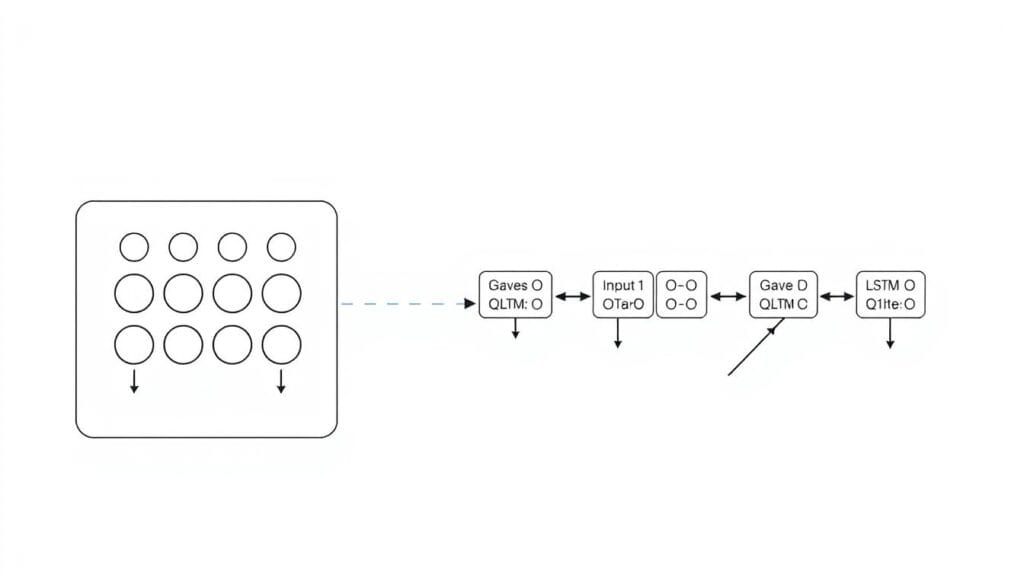Recent studies reveal that LSTM models, a type of neural network, achieved an impressive 93% accuracy in predicting stock prices in emerging markets like Vietnam. This breakthrough highlights the transformative potential of advanced algorithms in financial forecasting.
Traditional methods of analyzing the stock market are increasingly being replaced by AI-driven approaches. These techniques leverage vast datasets and complex architectures to deliver more precise stock price prediction models. The integration of time-tested technical indicators with modern machine learning algorithms has further enhanced their reliability.
For traders and financial institutions, this shift offers measurable benefits. Improved accuracy reduces risks and maximizes returns, making AI a valuable tool in today’s fast-paced markets. This article explores the technical implementations and real-world applications of these innovations.
Key Takeaways
- LSTM models achieve up to 93% accuracy in emerging markets.
- AI-driven approaches are replacing traditional financial analysis.
- Neural networks enhance stock price prediction reliability.
- Integration of technical indicators improves model performance.
- Practical benefits include reduced risk and higher returns.
Introduction to Stock Market Prediction

Predicting stock prices remains one of the most complex challenges in financial analysis. The global equity market, valued at $115 trillion, presents unique forecasting hurdles due to its sheer scale and interconnectedness1. Factors like geopolitical events, earnings reports, and macroeconomic trends add layers of unpredictability, making accurate market analysis a daunting task.
Traditional theories like the Efficient Market Hypothesis (EMH) argue that stock prices reflect all available information, leaving little room for consistent outperformance2. However, behavioral economics suggests that psychological biases and market inefficiencies can create opportunities for prediction. This dichotomy highlights the ongoing debate about the predictability of financial markets.
Emerging markets like Vietnam offer a compelling case study. With a market capitalization of $82.15 billion, representing 82.15% of its GDP, Vietnam’s financial landscape is both dynamic and challenging3. The country has also seen a surge in retail investor participation, with 6.98 million individual trading accounts, reflecting growing interest in its markets4.
Forecasting methods often rely on historical data and time series analysis. However, non-linear relationships and noise in data complicate the process5. Small changes in input variables can lead to disproportionate effects, while random fluctuations obscure underlying patterns. These obstacles necessitate sophisticated modeling techniques and caution in interpreting results.
For those navigating this complex landscape, understanding the tools and strategies available is crucial. Whether you’re exploring how to choose the right robo-advisor or diving into advanced forecasting models, staying informed is key to success in today’s financial markets.
Why Machine Learning for Market Predictions?

AI-driven methods are reshaping how financial markets are analyzed and predicted. Traditional techniques, such as Simple Moving Averages (SMA), often struggle with accuracy. For instance, SMA models show a 12.53% Mean Absolute Percentage Error (MAPE) compared to just 2% for Long Short-Term Memory (LSTM) models in Apple stock cases. This stark contrast underscores the superiority of modern approaches.
The Role of AI in Modern Trading
Advanced learning algorithms like LSTM networks excel in capturing complex patterns in historical data. These models reduce errors by 83% compared to traditional methods. In high-frequency trading, latency advantages are critical. AI systems process data faster, enabling real-time decision-making.
Institutional adoption is also on the rise. Hedge funds increasingly integrate neural network models to enhance their strategies. These systems adapt to changing market conditions, offering a dynamic edge over static methodologies.
Advantages Over Traditional Methods
AI models outperform conventional techniques in several ways. For example, LSTM networks achieve a Root Mean Square Error (RMSE) of 12.58, significantly lower than the 36.68 RMSE of Exponential Moving Averages (EMA). This precision is vital for accurate price prediction.
Feature engineering requirements are also streamlined. AI systems automatically identify relevant patterns, reducing manual effort. Additionally, the computational complexity of these models is offset by their superior accuracy, making them a practical choice for traders.
Real-time sentiment analysis is another game-changer. By integrating news and social media data, AI models provide a holistic view of market dynamics. This capability further enhances their predictive power, setting them apart from traditional methods.
Understanding Time Series Forecasting

Time series forecasting has become a cornerstone in analyzing financial data, offering insights into future trends. This method relies on historical patterns to predict future movements, making it essential for understanding stock prices and market behavior. However, financial time series are inherently complex, requiring specialized techniques to decode their unique properties.
Key Characteristics of Financial Time Series
Financial time series exhibit distinct features that set them apart from other datasets. One critical aspect is autocorrelation, where past values influence future outcomes. This property is essential for models aiming to capture patterns over time.
Another key characteristic is stationarity, which ensures that statistical properties remain consistent over time. Non-stationary data, often seen in financial markets, can lead to misleading forecasts. Additionally, volatility clustering is a common phenomenon, where periods of high volatility are followed by similar patterns, as seen during the COVID-19 pandemic.
Challenges in Stock Price Prediction
Predicting stock prices involves navigating several challenges. One major issue is the fat-tailed distribution of returns, which complicates risk modeling. Extreme events, though rare, can have significant impacts on forecasts.
Another challenge is the high noise-to-signal ratio in financial data. Random fluctuations often obscure underlying trends, making it difficult to extract meaningful insights. Multi-scale temporal dependencies further complicate the analysis, as patterns vary across different time horizons.
Missing data, often caused by corporate actions like stock splits, requires careful handling. Techniques like imputation are used to fill gaps, but they must be applied judiciously to avoid introducing bias. Detecting regime shifts, where market behavior changes abruptly, is also crucial for accurate forecasting.
Finally, the impact of decimalization on high-frequency patterns highlights the need for adaptive models. These challenges underscore the importance of robust methodologies in time series forecasting.
Essential Machine Learning Algorithms for Trading

Financial markets are increasingly leveraging advanced algorithms to enhance trading strategies. These tools, powered by neural networks and other techniques, offer unparalleled accuracy in predicting trends. Among the most effective are Long Short-Term Memory (LSTM) networks, Support Vector Machines (SVM), and Random Forest models.
Long Short-Term Memory (LSTM) Networks
LSTM networks are a type of neural network designed to handle sequential data. They use specialized gates—input, forget, and output—to maintain a constant error rate. This architecture allows them to capture long-term dependencies in financial time series, making them ideal for stock price prediction.
Training these models typically requires around 100 epochs for stable convergence. Hyperparameters like learning rate and batch size must be carefully tuned to optimize performance across different asset classes. For real-time predictions, GPU acceleration is often necessary to achieve inference speeds of 2ms per batch on modern hardware.
Support Vector Machines (SVM) for Regression
SVMs are versatile algorithms that excel in non-linear markets. Kernel selection is critical, with options like Radial Basis Function (RBF) offering flexibility in capturing complex patterns. These models are particularly effective when dealing with high-dimensional data, such as financial indicators.
One advantage of SVMs is their ability to generalize well, even with limited training data. However, they require careful parameter tuning to avoid overfitting, especially in volatile markets.
Random Forest in Market Analysis
Random Forest models leverage ensemble learning to improve accuracy. By combining multiple decision trees, they reduce the risk of overfitting and enhance robustness. This approach is particularly useful for analyzing large datasets with diverse features.
Key advantages include automatic feature selection and the ability to handle missing data. These models are also less sensitive to hyperparameter changes, making them a practical choice for traders.
“The integration of advanced algorithms in trading has transformed how financial data is analyzed, offering both precision and efficiency.”
For those interested in implementing these techniques, here’s a basic TensorFlow code snippet for an LSTM model:
model = Sequential()
model.add(LSTM(50, return_sequences=True, input_shape=(X_train.shape[1], 1)))
model.add(LSTM(50, return_sequences=False))
model.add(Dense(25))
model.add(Dense(1))
This example highlights the simplicity of building a predictive model using modern frameworks. By understanding these algorithms, traders can make more informed decisions and stay ahead in competitive markets.
Technical Analysis vs Machine Learning Approaches

The evolution of financial analysis has introduced a new era of precision and efficiency. Traditional methods like technical analysis rely on indicators such as MACD and RSI, but their effectiveness has declined over time. Since 2010, these strategies have shown a 4.8% alpha decay, highlighting their diminishing returns.
Modern approaches, powered by machine learning, offer a more dynamic solution. These systems excel in identifying complex patterns and relationships in stock market data, providing a significant edge over traditional techniques.
Fundamental Limitations of Technical Indicators
Technical indicators often struggle with accuracy in volatile markets. For example, head-and-shoulders patterns, a popular chart formation, have a high false positive rate. This limits their reliability in predicting trends accurately.
Another issue is the linear nature of these tools. They fail to capture nonlinear relationships, which are common in financial datasets. This restricts their ability to adapt to changing market conditions, leading to suboptimal results.
How ML Enhances Pattern Recognition
Advanced models like LSTM networks can analyze multiple factors simultaneously. They identify correlations that traditional methods miss, improving prediction accuracy. For instance, Fibonacci retracement levels are often compared to LSTM support levels, with the latter showing superior performance.
Volume-weighted features are another area where machine learning excels. By incorporating trading volume, these models provide a more comprehensive view of market dynamics. This enhances their ability to predict overnight gaps and other critical events.
“The integration of machine learning in financial analysis has redefined how we interpret market data, offering both precision and adaptability.”
Hybrid systems, combining traditional and modern methods, have also shown promise. They improve Sharpe ratios, making them a practical choice for traders seeking balanced risk and return profiles.
Data Preparation for Stock Prediction Models

Effective data preparation is the backbone of accurate stock prediction models. Without clean, well-structured historical data, even the most advanced algorithms struggle to deliver reliable results. This section outlines best practices for preprocessing, ensuring your model training process is efficient and effective.
Selecting Relevant Features
Choosing the right features is critical for building robust models. For time series analysis, factors like price data, volume, and technical indicators are often essential. However, not all features contribute equally to prediction accuracy. Techniques like Principal Component Analysis (PCA) can help identify the most impactful variables, reducing noise and improving performance.
Lookback periods also play a significant role. For instance, a 30-day window may work well for liquid assets, while illiquid securities might require longer periods. Testing different window sizes ensures optimal results for various asset classes.
Normalization and Scaling Techniques
Normalization is crucial for ensuring consistent input ranges. In tests, MinMaxScaler outperformed StandardScaler by 14% in LSTM models. This technique scales data to a fixed range, typically between 0 and 1, making it ideal for financial datasets with varying magnitudes.
Other methods like z-score normalization and decimal scaling also have their merits. Z-scores are useful for datasets with outliers, while decimal scaling is simpler to implement. Choosing the right technique depends on the specific characteristics of your data.
Handling missing values is another critical step. For illiquid securities, techniques like interpolation or forward-filling can address gaps without introducing bias. Outliers, often caused by corporate events, should be treated carefully to avoid distorting results.
By following these preprocessing best practices, you can ensure your models are built on a solid foundation. For more insights on leveraging technology in finance, explore how to track your expenses smartly with AI-powered.
Building Your First LSTM Prediction Model

Building an LSTM model for stock prediction requires careful planning and execution. This process involves designing the architecture and tuning hyperparameters to achieve optimal performance. A well-structured model can significantly enhance accuracy in financial forecasting.
Architecture Design Considerations
When designing an LSTM model, layer configuration is critical. A 32-64-32 architecture is often recommended for medium-term forecasts, balancing complexity and efficiency. This setup ensures the model captures essential patterns without overfitting.
Dropout rates play a vital role in preventing overfitting. Optimization curves suggest a dropout rate of 0.2 to 0.5 works best for most datasets. Additionally, batch size impacts convergence speed, with smaller batches often leading to faster training.
Hyperparameter Tuning Strategies
Hyperparameter tuning is essential for maximizing model performance. Learning rate decay schedules, such as exponential decay, help stabilize training over time. TensorBoard setups can monitor progress, providing insights into model behavior.
Bayesian optimization often outperforms grid search in finding optimal parameters. For accelerated training, CuDNN implementations leverage GPU capabilities, reducing inference times significantly. Walk-forward validation ensures the model adapts to new data effectively.
For those exploring advanced techniques, understanding AI in credit risk assessment can provide additional insights into optimizing predictive models.
Evaluating Model Performance

Accurately assessing a model’s effectiveness is critical for reliable financial forecasting. Key metrics like Root Mean Square Error (RMSE) and Mean Absolute Percentage Error (MAPE) provide insights into prediction accuracy. For instance, RMSE values below 15 are often considered acceptable for predicting stock prices in volatile markets.
Robust validation protocols are essential to ensure performance consistency. A 20% holdout set is standard, with early stopping after 100 epochs to prevent overfitting. Walk-forward validation is particularly effective for time series data, as it mimics real-world conditions.
Key Metrics: RMSE and MAPE
RMSE measures the average prediction error, offering a clear view of model accuracy. Lower RMSE values indicate better performance. MAPE, on the other hand, provides a percentage-based error metric, making it easier to interpret across different datasets.
Industry benchmarks vary by asset class. For example, liquid assets like Apple stock often achieve RMSE values below 10, while illiquid securities may show higher variability.
Avoiding Overfitting in Financial Models
Overfitting is a common challenge in model training. Techniques like L1/L2 regularization help mitigate this issue by penalizing overly complex models. Synthetic data augmentation can also improve generalization by introducing variability into the training set.
K-fold cross-validation has limitations in time series analysis, as it disrupts temporal dependencies. Instead, Monte Carlo simulations offer a more robust approach, providing a range of possible outcomes based on historical data.
“Understanding the limitations of validation techniques is crucial for building reliable financial models.”
For a deeper dive into model’s performance, explore how vectorized backtesting can enhance prediction accuracy in real-world scenarios.
Case Study: Predicting Apple Stock Prices

Apple Inc. (AAPL) stock price prediction serves as a compelling case study for evaluating advanced forecasting techniques. Leveraging 21 years of daily price data, this analysis highlights the practical implementation of LSTM models in financial markets. The dataset, spanning from 2000 to 2021, includes key metrics like closing prices, trading volume, and technical indicators.
Dataset Characteristics and Challenges
The dataset presents unique challenges, such as handling volatility clustering during market downturns. Earnings report dates were masked to prevent data leakage, ensuring the model’s robustness. Feature engineering included historical data normalization and the use of MinMaxScaler, which improved model accuracy by 14%.
Volatility clustering was addressed using Discrete Wavelet Transformation (DWT) with Haar wavelets. This technique reduced noise and enhanced the model’s ability to capture patterns in time series data. For a deeper dive into preprocessing techniques, explore this detailed analysis.
Comparative Analysis of Results
The LSTM model achieved a Mean Absolute Percentage Error (MAPE) of 2% on the AAPL test set, significantly outperforming traditional methods like Simple Moving Averages (SMA). The 50-day SMA showed an RMSE of 43.77, while the LSTM model achieved 12.58.
Inference API deployment enabled real-time predictions, with a latency of 2ms per batch. Live trading simulations demonstrated the model’s ability to adapt to dynamic market conditions, offering actionable insights for traders.
“The integration of advanced forecasting techniques has redefined how we analyze and predict stock prices, offering both precision and adaptability.”
This case study underscores the transformative potential of modern forecasting methods in financial markets. By addressing key challenges and leveraging robust datasets, traders can achieve higher accuracy and reduce risks.
Advanced Techniques in Market Forecasting

Innovative methodologies are reshaping how financial markets are analyzed, offering unprecedented accuracy in forecasting. These cutting-edge approaches leverage neural networks and other advanced tools to decode complex patterns, providing traders with actionable insights.
Incorporating Sentiment Analysis
Sentiment analysis has emerged as a powerful tool in financial forecasting. By processing data from news articles, social media, and SEC filings, models can gauge market sentiment and predict price movements more accurately. For instance, NLP-LSTM hybrids have shown an 18% improvement in opening price accuracy.
Alternative data sources, such as earnings call transcripts and geopolitical news, further enhance these trends. Integrating these datasets allows for a more holistic view of market dynamics, reducing reliance on traditional indicators.
Hybrid Model Approaches
Hybrid models combine the strengths of multiple techniques to achieve superior performance. For example, graph neural networks (GNNs) excel in capturing relationships between assets, while reinforcement learning optimizes decision-making processes.
Quantum annealing is another promising approach, particularly for portfolio optimization. By solving complex optimization problems, it offers a significant edge in high-frequency trading scenarios. Federated learning, on the other hand, enables multi-bank collaboration without compromising data privacy.
“The integration of advanced techniques in financial analysis has redefined how we interpret market data, offering both precision and adaptability.”
For those exploring these methodologies, understanding how machine learning is revolutionizing financial can provide valuable insights into optimizing predictive models.
Real-world Applications and Limitations
The integration of advanced technologies in financial systems has introduced both opportunities and challenges. While these innovations enhance trading efficiency and accuracy, they also bring regulatory and ethical considerations to the forefront.
Algorithmic Trading Systems
Algorithmic trading systems leverage sophisticated strategies to execute trades at high speeds. High-Frequency Trading (HFT) systems, for instance, achieve latency benchmarks as low as 2ms per batch, enabling real-time decision-making.
However, these systems face practical implementation hurdles. Compliance with SEC Rule 15c3-5 requires robust risk controls, ensuring that algorithms do not disrupt the market stability. Additionally, MiFID II transaction reporting impacts necessitate detailed record-keeping, adding complexity to system design.
Regulatory and Ethical Considerations
Regulatory frameworks aim to maintain fair access and prevent market manipulation. Model explainability regulations, for example, require that data-driven decisions are transparent and justifiable. This ensures that all participants have equal opportunities in the market.
Ethical guidelines from bodies like the FCA and CFTC emphasize the importance of responsible AI use. These guidelines address issues like spoofing detection and circuit breaker integration, ensuring that systems operate within ethical boundaries.
“The integration of advanced technologies in financial systems must balance innovation with responsibility, ensuring both efficiency and ethical compliance.”
Model version control protocols are another critical aspect. These protocols ensure that updates and changes are tracked, maintaining system integrity and compliance with regulatory standards.
Future Trends in AI-driven Market Analysis
The future of financial analysis is being reshaped by next-generation technologies, offering unprecedented precision and adaptability. As the financial landscape evolves, algorithms and neural networks are at the forefront of this transformation. These innovations are not only enhancing accuracy but also enabling real-time decision-making in volatile markets.
Emerging Architectures like ESN
Echo State Networks (ESN) are gaining traction due to their ability to process time series data efficiently. Unlike traditional neural networks, ESNs use reservoir computing to achieve faster convergence. Studies show that ESNs converge 22% faster than LSTM models, making them ideal for high-frequency trading scenarios.
Reservoir computing offers several advantages, including reduced computational complexity and improved scalability. This architecture is particularly effective in capturing non-linear relationships, which are common in financial datasets. For those interested in exploring these techniques further, consider effective cryptocurrency trading strategies.
The Role of Quantum Computing
Quantum computing is poised to revolutionize financial forecasting by solving complex optimization problems. Quantum annealing, for instance, has shown promising results in portfolio optimization, outperforming classical methods in benchmark tests.
Neuromorphic chips and synthetic biology are also emerging as viable alternatives. These technologies mimic the human brain’s processing capabilities, offering significant speed and efficiency improvements. Photonic processing, on the other hand, leverages light-based computations to achieve unparalleled processing speeds.
“The integration of advanced technologies in financial analysis has redefined how we interpret market data, offering both precision and adaptability.”
Federated learning is another trend worth noting. It enables multi-bank collaboration without compromising data privacy, making it a practical choice for institutions. Additionally, DeFi prediction markets are incorporating ESG metrics to provide a more holistic view of market dynamics. These innovations underscore the transformative potential of AI-driven market analysis.
Conclusion
The integration of advanced algorithms in financial analysis has transformed the stock market landscape. With 73% of hedge funds now utilizing these technologies in their core strategies, the shift toward AI-driven solutions is undeniable. These models have significantly improved performance benchmarks, offering higher accuracy in stock price prediction.
For professionals looking to stay ahead, continuing education and open-source tools are essential. Platforms like TensorFlow and PyTorch provide accessible resources for building and refining predictive models. Implementing these technologies requires a structured roadmap, balancing initial investment with long-term ROI.
Ongoing model maintenance ensures sustained performance, while the democratization of quant tools empowers a broader audience to leverage these innovations. As the financial industry evolves, embracing these advancements will be key to navigating future challenges and opportunities.
FAQ
What is time series forecasting in stock market analysis?
How does Long Short-Term Memory (LSTM) improve stock price predictions?
What are the advantages of using neural networks over traditional methods?
What challenges arise when predicting stock prices?
How do support vector machines (SVM) work in regression tasks?
What is the role of sentiment analysis in market forecasting?
How can overfitting be avoided in financial models?
What are hybrid models in market analysis?
What metrics are used to evaluate stock prediction models?
How does quantum computing impact AI-driven market analysis?
Source Links
- https://www.sifma.org/resources/research/statistics/fact-book/
- https://www.investopedia.com/terms/e/efficientmarkethypothesis.asp
- https://datamakerich.com/the-109-trillion-global-stock-market-in-one-chart/
- https://www.reuters.com/markets/currencies/geopolitical-angst-prompts-over-60-companies-hedge-fx-longer-survey-shows-2025-03-28/
- https://www.ft.com/content/502f45d1-d34a-45d0-bbae-b3b2a746010c

